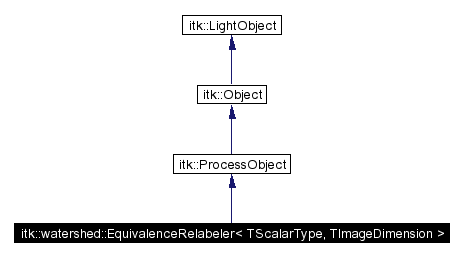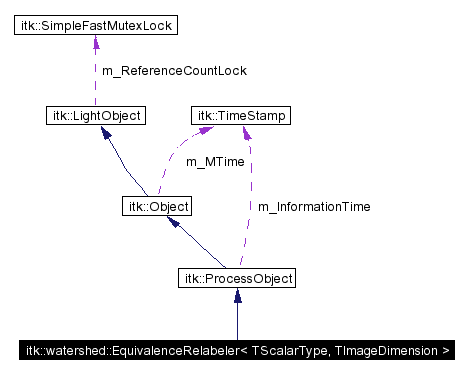
#include <itkWatershedEquivalenceRelabeler.h>
Inheritance diagram for itk::watershed::EquivalenceRelabeler:


Definition at line 52 of file itkWatershedEquivalenceRelabeler.h.
|
|||||
|
Define smart pointers for this object. Reimplemented from itk::ProcessObject. Definition at line 70 of file itkWatershedEquivalenceRelabeler.h. |
|
|||||
|
Smart Pointer type to a DataObject. Reimplemented from itk::ProcessObject. Definition at line 66 of file itkWatershedEquivalenceRelabeler.h. |
|
|||||
|
Definition at line 64 of file itkWatershedEquivalenceRelabeler.h. |
|
|||||
|
Some convenient typedefs. Definition at line 60 of file itkWatershedEquivalenceRelabeler.h. |
|
|||||
|
Define smart pointers for this object. Reimplemented from itk::ProcessObject. Definition at line 69 of file itkWatershedEquivalenceRelabeler.h. |
|
|||||
|
Definition at line 63 of file itkWatershedEquivalenceRelabeler.h. |
|
|||||
|
Definition at line 65 of file itkWatershedEquivalenceRelabeler.h. |
|
|||||
|
Standard class typedefs. Reimplemented from itk::ProcessObject. Definition at line 61 of file itkWatershedEquivalenceRelabeler.h. |
|
|||||
|
Reimplemented from itk::ProcessObject. Definition at line 62 of file itkWatershedEquivalenceRelabeler.h. |
|
|||||||||
|
Definition at line 114 of file itkWatershedEquivalenceRelabeler.h. |
|
|||||||||
|
Definition at line 121 of file itkWatershedEquivalenceRelabeler.h. |
|
||||||||||
|
Definition at line 122 of file itkWatershedEquivalenceRelabeler.h. |
|
|||||||||
|
Standard non-threaded pipeline method Reimplemented from itk::ProcessObject. |
|
|||||||||
|
What is the input requested region that is required to produce the output requested region? By default, the largest possible region is always required but this is overridden in many subclasses. For instance, for an image processing filter where an output pixel is a simple function of an input pixel, the input requested region will be set to the output requested region. For an image processing filter where an output pixel is a function of the pixels in a neighborhood of an input pixel, then the input requested region will need to be larger than the output requested region (to avoid introducing artificial boundary conditions). This function should never request an input region that is outside the the input largest possible region (i.e. implementations of this method should crop the input requested region at the boundaries of the input largest possible region). Reimplemented from itk::ProcessObject. |
|
||||||||||
|
Given one output whose requested region has been set, how should the requested regions for the remaining outputs of the process object be set? By default, all the outputs are set to the same requested region. If a filter needs to produce different requested regions for each output, for instance an image processing filter producing several outputs at different resolutions, then that filter may override this method and set the requested regions appropriatedly. Note that a filter producing multiple outputs of different types is required to override this method. The default implementation can only correctly handle multiple outputs of the same type. Reimplemented from itk::ProcessObject. |
|
|||||||||
|
Define smart pointers for this object. Reimplemented from itk::ProcessObject. |
|
|||||||||
|
Set/Get the table to use in relabeling the input image. Definition at line 100 of file itkWatershedEquivalenceRelabeler.h. |
|
||||||||||
|
Set/Get the image to relabel. Definition at line 78 of file itkWatershedEquivalenceRelabeler.h. |
|
|||||||||
|
Set/Get the output image Definition at line 90 of file itkWatershedEquivalenceRelabeler.h. |
|
||||||||||||||||||||
|
Expose templated image dimension parameter at run time |
|
||||||||||
|
Standard itk::ProcessObject subclass method. Reimplemented from itk::ProcessObject. |
|
|||||||||
|
Define smart pointers for this object. Reimplemented from itk::Object. |
|
||||||||||
|
Reimplemented from itk::ProcessObject. Definition at line 123 of file itkWatershedEquivalenceRelabeler.h. |
|
||||||||||||||||
|
Methods invoked by Print() to print information about the object including superclasses. Typically not called by the user (use Print() instead) but used in the hierarchical print process to combine the output of several classes. Reimplemented from itk::ProcessObject. |
|
||||||||||
|
Set/Get the table to use in relabeling the input image. Definition at line 96 of file itkWatershedEquivalenceRelabeler.h. |
|
||||||||||
|
Set/Get the image to relabel. Definition at line 76 of file itkWatershedEquivalenceRelabeler.h. |
|
||||||||||
|
Set/Get the output image Definition at line 86 of file itkWatershedEquivalenceRelabeler.h. |
 1.2.15 written by Dimitri van Heesch,
© 1997-2000
1.2.15 written by Dimitri van Heesch,
© 1997-2000